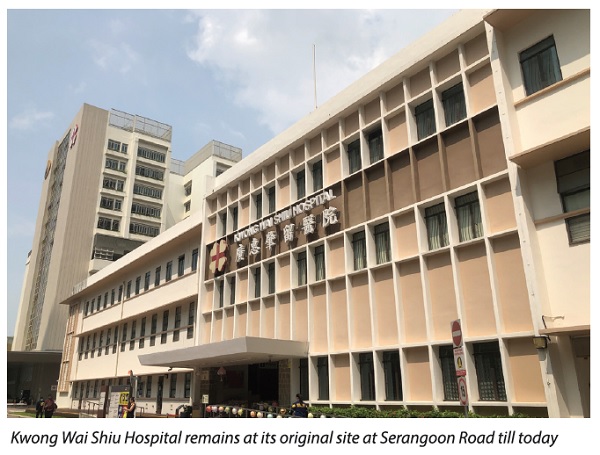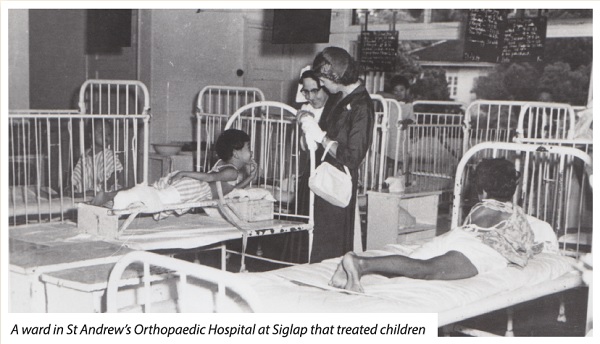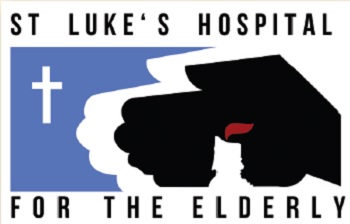Adequate healthcare access is an important factor for good population health, but there are still groups of people who struggle financially and thus face difficulty affording such care. Thankfully, there are many charitable medical institutions in Singapore that have set out to ensure that affordable and appropriate medical services are made available to people of all ages and means within our society. In this article, we feature four such organisations who share their respective journeys and efforts in bringing healthcare to all in need.
Choo Shiu Ling
A life well-lived should be celebrated, lives less heralded deserve to be treated with dignity, and all deserve good palliative care. Life's final journey is also our final opportunity to express the importance of our shared humanity – to express the fact that every individual, regardless of how one's life has been lived, is of great value.
The Assisi Hospice was formed with the purpose of doing our best to provide for unmet palliative care needs in persons with serious life-limiting illnesses. We discern what the community needs and transform ourselves to achieve it. We provide palliative care in our purpose-built inpatient facility, at our day care centre and with our expanding home care service. More recently, we developed our grief and bereavement service to ensure our programmes can address the spectrum of needs faced by bereaved caregivers.
Responding to the community
In 2015, we served 986 patients, managed 818 new admissions (351 inpatients, 430 home care and 37 day care patients) and had 566 patients who died with dignity under our care. However, we saw that there were many unmet needs and knew that we needed to do more.
Today, the Assisi team can annually serve up to 3,400 patients, manage 2,700 new admissions (900 inpatients, 1,700 home care and 100 day care patients) and care for 1,800 patients dying with dignity and comfort.
Beyond the need to serve more, the team also understood that we needed to increase our skills to manage both cancer and non-cancer serious illnesses, including those requiring complex care. This would right-site patients from the acute hospitals to be cared for either at home by the Assisi home care team, or at our Assisi inpatient unit.
Good access to care with no concern about affordability is essential. We actively seek to identify and serve marginalised groups (such as prisoners without parole), and 50% of our patients are in the lowest income level when means-tested. Our clinical team admits patients based on clinical needs, and financial status is not part of the consideration for admission.
Improving life
Patients are living longer with serious life-limiting illnesses because of medical advances that can prolong life without necessarily improving the quality of life. Medical devices and therapeutics have raised the life expectancy of those with cancers and end-stage organ failure; as such, where dying used to take days or weeks, it may now take months to years, preceded by a period of progressive disability. There is good evidence to show unrecognised and unrelieved suffering in these patients.
The interplay of our physical, psychosocial, emotional and spiritual beings can be complex, especially when coping with serious illness. An interdisciplinary palliative care team has the professional skills, aptitude and disposition to provide care for patients and families in a time of great vulnerability and need. It is during this time that the Assisi team tries to help patients and loved ones live well and even treasure the final journey.
Our task on this earth has always been to acknowledge and respond to our shared humanity, to care for those more vulnerable, and to use our best abilities in service to others.
Mok Ying Jang
Kwong Wai Shiu Hospital (KWSH) is one of the oldest charitable institutions in Singapore. It was founded in 1910 by Cantonese merchants who wanted to provide free medical services to poor Chinese immigrants. Since then, KWSH has expanded its mission to provide affordable and quality healthcare services to the sick and needy in the community.
Over time, the hospital has adapted its services to meet the evolving needs of the nation, from the setup of tuberculosis and maternity wards during the early 1900s to becoming a leading charitable healthcare institution catering to the needs of Singapore's ageing population today.
From then till now
KWSH was the first hospital in Singapore to offer patients the option of either traditional Chinese medicine (TCM) or Western medicine treatments. Today, we continue to provide TCM for outpatient services and have also integrated it into inpatient services in the nursing homes.
KWSH currently operates a network of two nursing homes at Serangoon and Potong Pasir, and six active ageing and care centres in the Central Singapore district. We continue our strong partnership with the National Healthcare Group and tap on their expertise to support and enhance care for our residents.
Our six active ageing and care centres serve as a gathering point for those residing in the neighbourhood. Residents can participate in carefully designed activities and programmes such as fitness and music classes, which are catered to the seniors' well-being and interests.
The activities and festive events for our inpatient and day centres' residents are made possible with the support of a group of active volunteers supporting the hospital. As most of our patients are from lower-income groups and require financial assistance, KWSH holds fundraising events throughout the year to raise much-needed funds to sustain our operations and expansion plans.
Preparing for the days ahead
To meet the future needs of Singapore's ageing population, KWSH has put in place a ten-year strategic plan to expand our facilities and programmes in order to support national initiatives and better serve the community. The plan includes increasing the nursing homes' bed capacity and expanding the network of active ageing and care centres. More importantly, it is to help seniors age healthily in their homes and communities through our comprehensive programmes and services.
The plan also includes a focus on training healthcare workers. Our Community Training Institute is an appointed SkillsFuture Queen Bee by SkillsFuture Singapore, and we partner with the Agency for Integrated Care, institutes of higher learning and community partners to uplift the skillsets and standards of community healthcare workers.
I look forward to the exciting journey of continuing this mission, positively impacting and extending our reach to a wider community, as enshrined in our founding philosophy – “任重道远” (an arduous journey, a lifetime commitment).

Arthur Chern
After the founding of modern Singapore by Sir Stamford Raffles in 1819, the first local Anglican church, Saint Andrew's Church, was built in 1837. In 1909, the Diocese of Singapore was established.
Early days of the mission
Charles Ferguson-Davie was the first Anglican Bishop of Singapore and he served alongside his wife, Charlotte Ferguson-Davie, a medical doctor. The Singapore of the 1910s was a very different place; the infrastructure was unable to manage the large influx of immigrants. Due to poor public hygiene and a lack of proper medical facilities, childbirth was extraordinarily risky and the infant mortality rate was as high as 30%.
Dr Charlotte decided to act for the poor women and children she frequently encountered in the Chinatown area. She thus founded the St Andrew's Medical Mission and started the first clinic at Bencoolen Street in 1913, followed by a second clinic at Upper Cross Street, and a third clinic at Pasir Panjang to serve the Malay Village.
In 1923, Dr Charlotte started the first women's and children's hospital in Singapore at Erskine Road (next to present-day Maxwell Road) – the St Andrew's Mission Hospital (SAMH). It had 60 beds, an OT, a delivery room and an outpatient clinic. In 1924, the hospital's services expanded to include clinics for venereal disease, eye and antenatal care – some of the major medical problems faced by the migrant population then. She also saw the need to build up the local professional manpower, and SAMH was the first to run three-year general courses in nursing and midwifery for locals.
In 1939, SAMH started its second hospital at Siglap: the St Andrew's Orthopaedic Hospital. This hospital was set up to treat children with musculoskeletal problems, especially tuberculosis of the bones and joints, and polio, which were rampant during that time.

Even during the difficult period of World War II, SAMH continued functioning as the Shimin Byoin (Japanese for People's Hospital), with two local doctors and a few local nurses who had been posted there by the Japanese authorities.
After the war, the hospital restarted at Tanjong Pagar. However, disease patterns and societal needs were changing, and tuberculosis and polio had come under control. Eventually the two hospitals closed in the 1980s, but our passion to serve did not stop there. Looking at the nation's rapidly ageing population, we embarked on a new model of hospital care and started Singapore's first community hospital in 1992: the St Andrew's Community Hospital. Its main aim was to provide intermediate care for patients, especially the elderly, after they have received acute care in a general hospital.
Growing as a group
We adopted a new growth strategy at our 100-year anniversary in 2013: to become a nationwide multi-service agency, especially in the field of nursing home service, to meet the needs of our rapidly ageing society. Today, we have seven nursing homes across the island with the eighth in the pipeline. Together, they total about 2,500 beds, making us one of the largest nursing home operators in Singapore.
We have grown as a group together with our sister organisation, the Singapore Anglican Community Services. Operating 42 centres, we serve nearly 50,000 beneficiaries each year with our five key pillars of services: medical, senior, autism, psychiatric, and family and children. Our services now include not only our community hospital and its ancillary services (eg, home care, palliative care and migrant worker medical centres), but also nursing homes; day care and active ageing centres; autism schools, day activity centres and adult homes; psychiatric rehabilitation and day centres; family crisis shelters; and student services.
Our 110 years of history is documented in the book Let The Flame Burn Brighter, which is available via our website.
Tan Boon Yeow
In the ever-evolving healthcare landscape, St Luke's Hospital's (SLH) journey has been one characterised by courage and passion. Celebrating its 27th anniversary this year, I am reminded of my commitment to SLH's motto to "Serve, Love and Heal our patients". It is a tribute to the ideals of Saint Luke, the patron saint of the medical profession for whom SLH is named after.
Journey of courage and passion
SLH was started to meet the needs of the vulnerable and the older sick person. Today, we continue to meet needs that are often underserved by others – catering to the complex care requirements of older persons grappling with functional loss, limited caregiver support and financial challenges.
The idea to set up SLH was first mooted by a group of Christian doctors and nurses after a 1989 report from the Advisory Council on the Aged raised important issues on the lack of adequate elderly care facilities and resources in Singapore to provide appropriate healthcare services to our ageing population in 2030. Our pioneers saw the need to create a haven for those in recovery, especially for the underprivileged.
This vision was beautifully encapsulated in our original logo depicting a tender, loving human hand with the hand of God alongside, both shielding the flickering candle flame which symbolises the vulnerable, and pointing to the Cross, the source of our hope.

My journey with SLH started in the early 1990s as a modest donor, when the hospital was "selling bricks" to raise funds I was still a medical student at the time and I bought one in support. Inspired by the hospital's compelling mission, I requested to be posted to SLH in 1999 as a medical officer seconded from the Ministry of Health. What I experienced was an inspirational clinical space that had great potential to transform the lives of those whom we serve.
Serving as a bridge between the acute hospital and the patient's home or a nursing home, possibilities abounded in many areas where I could help patients improve their health. As the duration of a patient's stay in a community hospital is usually between three and four weeks, the posting allowed me many opportunities to know my patients better through regular interactions and also to introduce other crucial service interventions beyond clinical care, which could help improve their overall wellness.
Clinical, social and pastoral care
The World Health Organization (WHO) defines health as "a state of complete physical, mental, and social well-being and not merely the absence of disease or infirmity".1
At SLH, we care for the whole person through our holistic clinical, social and pastoral model of care, addressing not only their physical needs, but also their social, emotional and spiritual needs. As Singapore's healthcare needs evolved, our services grew in tandem, creating a comprehensive ecosystem to deliver integrated care that spans the preventive, curative and end-of-life care spectrum.
To enhance our care, SLH has also onboarded the principles of the WHO's International Classification of Functioning, Disability and Health framework, to aid in goal setting for each person that we serve, especially those with functional impairment. This helps our team remain person-centric in the delivery of care as we aspire to restore our patients beyond wellness to wholeness.
Through our efforts, we also hope to be an inspiration to all healthcare providers in embracing a holistic and compassionate model of care, one that cares for the person beyond the patient.